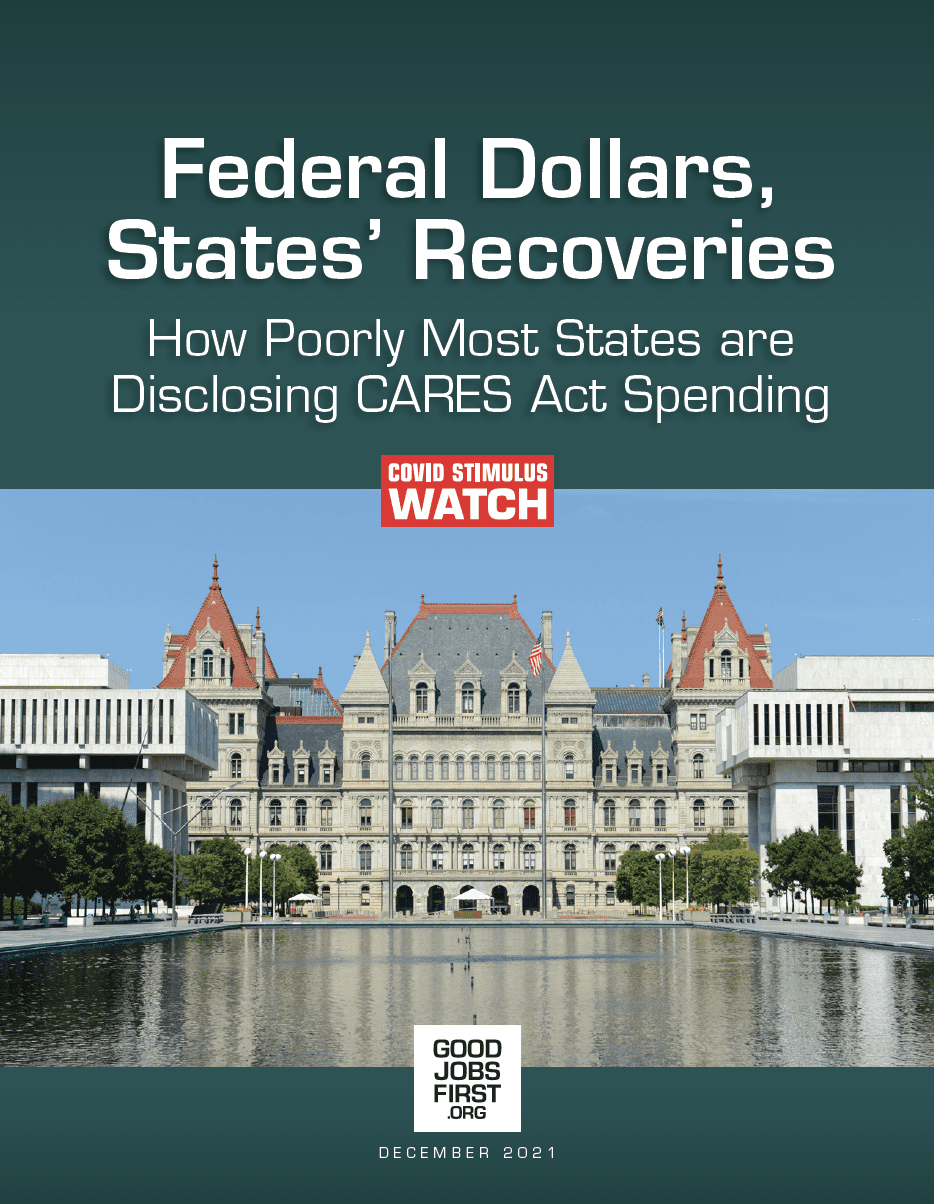Transparency Fail: Online Disclosures Provide an Incomplete Picture of How Public Money is Being Spent
Most states are failing to provide a full and complete picture of how they have been spending billions of dollars in assistance provided by Congress to help their residents recover from the financial burdens caused by COVID-19 pandemic.
In fact, just six states do it well: Alabama, Georgia, Illinois, Massachusetts, Michigan, and Wyoming. Eight states and the District of Columbia fail to disclose any meaningful information online.
These are among the findings from a Good Jobs First review of the online disclosure practices of the 50 states and the District of Columbia, as they have spent a combined $111.8 billion from the Coronavirus Relief Fund (CRF). The paper, “Federal Dollars, States’ Recoveries: How Poorly Most States are Disclosing CARES ACT Spending,” evaluates the accessibility and content of each state’s CRF website and highlights examples of good and bad disclosure.
The Coronavirus Relief Fund, a provision of the 2020 CARES Act, directly funds states to cover COVID-related costs through the end of 2021. The money – $150 billion in all, which also flows to large localities, territories, and tribal governments – intentionally gives state leaders wide flexibility for how the money was spent, to target the specific needs of their residents. Disclosing how the money was spent the money is crucial to enable the public to determine whether it was put to good use.
Most states have created websites and landing pages that track program spending, listing awardee names and allocations to state agencies. But the websites often lack details on how awardees spent their funds – which were often paid in large blocks.
“It’s not enough to know the state’s Health and Human Services Department, for example, got $500 million. Residents need to be able to see how each department spent what it got,” said Katie Furtado, Good Jobs First Research Analyst and the report’s author. “There’s no excuse for disclosure to be so poor in so many places, especially with some states proving that it definitely can be done.”
Three states with exemplary disclosure are detailed as case studies in the paper: Alabama, Georgia, and Wyoming.
Alabama’s site contains a matrix that discloses all of the state’s expenditures. Georgia is one of only a few states that provide spending details beyond the CARES Act’s required expenditure categories. Wyoming’s website has a dataset of individual expenditures that includes recipients, award amounts, dates of disbursement, allocation agencies, expenditure categories, and brief expense descriptions.
Poor-disclosing states include New York and Texas – two states which received among the most CRF money. New York’s page is difficult to find and provides no details on expenditures. Texas offers little in the way of detail on its CRF page and instead places what little information it does have on the state’s open data portal website, a place most residents don’t know about and would have trouble finding.
Arizona, Kentucky, Maryland, Missouri, Nevada, Oregon, Pennsylvania, and Virginia, as well as Washington, DC, have no site at all.
“We’ve seen CRF used on things like stadium turnstiles and upgrades to golf courses, while millions of people are afraid to return to work. Transparency enables residents to track these decisions,” said Good Jobs First Executive Director Greg LeRoy. “Communities must be part of the group making decisions.”
Despite the poor transparency so far, states have plenty of time to catch up. They can retroactively post information on past expenditures, as well as allocations that are yet to be spent. And states have another, even bigger pot of money to track: the $195 billion in state aid from the Coronavirus State and Local Fiscal Recovery Fund (CSLFRF) included in the 2021 American Rescue Plan Act (another $155 billion went to other localities, territories, and tribal nations).
Based on our observations, we recommend that the federal government help the states in this effort by adopting the following policies:
- The U.S. Treasury should revise its required categories for the final CRF quarterly reports to match those that are currently being used for CSLFRF reporting;
- Governments receiving CRF and CSLFRF money should be required to have a website landing page that tracks their COVID spending activities;
- Governments spending CRF and CSLFRF money should be required to post quarterly reports to the U.S. Treasury broken down by agency, sub-recipient, and vendor; and|
- All CRF and CSLFRF prime recipients should take care to highlight their education department data.
Update 1/4/2021: After this report was published, officials at the Pandemic Response Accountability Committee (PRAC) brought to our attention that the Coronavirus Relief Fund spending data posted at on pandemicoversight.gov is cumulative, despite the columns being labeled for only the latest quarter. We had reached out to PRAC while writing the report to fact-check our findings, which included our observation that only the most recent quarter’s data was publicly showing, but PRAC did not respond.
Read the full report here.
